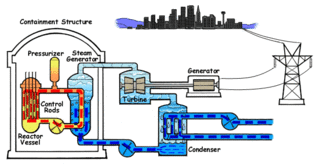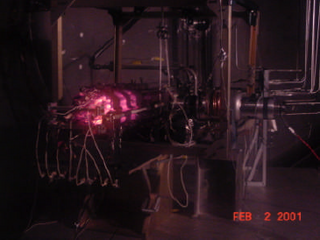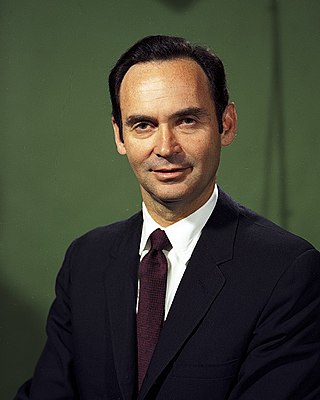Related Research Articles

A nuclear thermal rocket (NTR) is a type of thermal rocket where the heat from a nuclear reaction replaces the chemical energy of the propellants in a chemical rocket. In an NTR, a working fluid, usually liquid hydrogen, is heated to a high temperature in a nuclear reactor and then expands through a rocket nozzle to create thrust. The external nuclear heat source theoretically allows a higher effective exhaust velocity and is expected to double or triple payload capacity compared to chemical propellants that store energy internally.
A nuclear electric rocket is a type of spacecraft propulsion system where thermal energy from a nuclear reactor is converted to electrical energy, which is used to drive an ion thruster or other electrical spacecraft propulsion technology. The nuclear electric rocket terminology is slightly inconsistent, as technically the "rocket" part of the propulsion system is non-nuclear and could also be driven by solar panels. This is in contrast with a nuclear thermal rocket, which directly uses reactor heat to add energy to a working fluid, which is then expelled out of a rocket nozzle.

Nuclear pulse propulsion or external pulsed plasma propulsion is a hypothetical method of spacecraft propulsion that uses nuclear explosions for thrust. It originated as Project Orion with support from DARPA, after a suggestion by Stanislaw Ulam in 1947. Newer designs using inertial confinement fusion have been the baseline for most later designs, including Project Daedalus and Project Longshot.

Nuclear propulsion includes a wide variety of propulsion methods that use some form of nuclear reaction as their primary power source. The idea of using nuclear material for propulsion dates back to the beginning of the 20th century. In 1903 it was hypothesized that radioactive material, radium, might be a suitable fuel for engines to propel cars, planes, and boats. H. G. Wells picked up this idea in his 1914 fiction work The World Set Free. Many aircraft carriers and submarines currently use uranium fueled nuclear reactors that can provide propulsion for long periods without refueling. There are also applications in the space sector with nuclear thermal and nuclear electric engines which could be more efficient than conventional rocket engines.

Project Prometheus was established in 2003 by NASA to develop nuclear-powered systems for long-duration space missions. This was NASA's first serious foray into nuclear spacecraft propulsion since the cancellation of the SNTP project in 1995. The project was planned to design, develop, and fly multiple deep space missions to the outer planets.

The Nuclear Engine for Rocket Vehicle Application was a nuclear thermal rocket engine development program that ran for roughly two decades. Its principal objective was to "establish a technology base for nuclear rocket engine systems to be utilized in the design and development of propulsion systems for space mission application". It was a joint effort of the Atomic Energy Commission (AEC) and the National Aeronautics and Space Administration (NASA), and was managed by the Space Nuclear Propulsion Office (SNPO) until the program ended in January 1973. SNPO was led by NASA's Harold Finger and AEC's Milton Klein.
A radioisotope rocket or radioisotope thermal rocket is a type of thermal rocket engine that uses the heat generated by the decay of radioactive elements to heat a working fluid, which is then exhausted through a rocket nozzle to produce thrust. They are similar in nature to nuclear thermal rockets such as NERVA, but are considerably simpler and often have no moving parts. Alternatively, radioisotopes may be used in a radioisotope electric rocket, in which energy from nuclear decay is used to generate the electricity used to power an electric propulsion system.

SNAP-10A was a US experimental nuclear powered satellite launched into space in 1965 as part of the SNAPSHOT program. The test marked both the world's first operation of a nuclear reactor in orbit, and the first operation of an ion thruster system in orbit. It is the only fission reactor power system launched into space by the United States. The reactor stopped working after just 43 days due to a non-nuclear electrical component failure. The Systems Nuclear Auxiliary Power Program reactor was specifically developed for satellite use in the 1950s and early 1960s under the supervision of the U.S. Atomic Energy Commission.
The Westinghouse Astronuclear Laboratory (WANL) was a division of Westinghouse Electric Corporation. Established in 1959 to develop nuclear space propulsion technologies for the government, the lab was located, for most of its history, in the paradoxically small town of "Large" along Pa. Rte 51, about 13 miles (21 km) south of Pittsburgh in Allegheny County, Pennsylvania, USA. The site is not far from the Bettis Atomic Power Laboratory in West Mifflin, which Westinghouse operated during the same time and later.

The Aircraft Nuclear Propulsion (ANP) program and the preceding Nuclear Energy for the Propulsion of Aircraft (NEPA) project worked to develop a nuclear propulsion system for aircraft. The United States Army Air Forces initiated Project NEPA on May 28, 1946. NEPA operated until May 1951, when the project was transferred to the joint Atomic Energy Commission (AEC)/USAF ANP. The USAF pursued two different systems for nuclear-powered jet engines, the Direct Air Cycle concept, which was developed by General Electric, and Indirect Air Cycle, which was assigned to Pratt & Whitney. The program was intended to develop and test the Convair X-6, but was canceled in 1961 before that aircraft was built. The total cost of the program from 1946 to 1961 was about $1 billion.
Project Timberwind aimed to develop nuclear thermal rockets. Initial funding by the Strategic Defense Initiative from 1987 through 1991 totaled $139 million (then-year). The proposed rocket was later expanded into a larger design after the project was transferred to the Air Force Space Nuclear Thermal Propulsion (SNTP) program.
Westinghouse Advanced Energy Systems Division (AESD) was a research and development facility for nonconventional renewable energy systems, in the small town of Large in Allegheny County, Pennsylvania [USA]. The site is on the east side of Pa. Rte. 51, about 13 miles (21 km) south of Pittsburgh. Formerly the site of the Westinghouse Astronuclear Laboratory (WANL), Westinghouse Electric Corporation changed the name of the facility, along with its charter, in 1977.

Safe affordable fission engine (SAFE) were NASA's small experimental nuclear fission reactors for electricity production in space. Most known was the SAFE-400 reactor concept intended to produce 400 kW thermal and 100 kW electrical using a Brayton cycle closed-cycle gas turbine. The fuel was uranium nitride in a core of 381 pins clad with rhenium. Three fuel pins surround a molybdenum–sodium heatpipe that transports the heat to a heatpipe-gas heat exchanger. This was called a heatpipe power system. The reactor was about 50 centimetres (20 in) tall, 30 centimetres (12 in) across and weighed about 512 kilograms (1,129 lb). It was developed at the Los Alamos National Laboratory and the Marshall Space Flight Center under the lead of Dave Poston. A smaller test reactor called SAFE-30 was first built.

Project Rover was a United States project to develop a nuclear-thermal rocket that ran from 1955 to 1973 at the Los Alamos Scientific Laboratory (LASL). It began as a United States Air Force project to develop a nuclear-powered upper stage for an intercontinental ballistic missile (ICBM). The project was transferred to NASA in 1958 after the Sputnik crisis triggered the Space Race. It was managed by the Space Nuclear Propulsion Office (SNPO), a joint agency of the Atomic Energy Commission (AEC), and NASA. Project Rover became part of NASA's Nuclear Engine for Rocket Vehicle Application (NERVA) project and henceforth dealt with the research into nuclear rocket reactor design, while NERVA involved the overall development and deployment of nuclear rocket engines, and the planning for space missions.
A thermal rocket is a rocket engine that uses a propellant that is externally heated before being passed through a nozzle to produce thrust, as opposed to being internally heated by a redox (combustion) reaction as in a chemical rocket.

Harold Benjamin Finger is an American aeronautical nuclear engineer and the former head of the United States nuclear rocket program. He helped establish and lead the Space Nuclear Propulsion Office, a liaison organization between NASA and the Atomic Energy Commission to coordinate efforts to create a nuclear thermal rocket.

Raemer Edgar Schreiber was an American physicist from McMinnville, Oregon who served Los Alamos National Laboratory during World War II, participating in the development of the atomic bomb. He saw the first one detonated in the Trinity nuclear test in July 1945, and prepared the Fat Man bomb that was used in the bombing of Nagasaki. After the war, he served at Los Alamos as a group leader, and was involved in the design of the hydrogen bomb. In 1955, he became the head of its Nuclear Rocket Propulsion (N) Division, which developed the first nuclear-powered rockets. He served as deputy director of the laboratory from 1972 until his retirement in 1974.

Kilopower is an experimental U.S. project to make new nuclear reactors for space travel. The project started in October 2015, led by NASA and the DoE’s National Nuclear Security Administration (NNSA). As of 2017, the Kilopower reactors were intended to come in four sizes, able to produce from one to ten kilowatts of electrical power (1–10 kWe) continuously for twelve to fifteen years. The fission reactor uses uranium-235 to generate heat that is carried to the Stirling converters with passive sodium heat pipes. In 2018, positive test results for the Kilopower Reactor Using Stirling Technology (KRUSTY) demonstration reactor were announced.

Milton Klein was an American nuclear engineer who was the head of the United States nuclear rocket program. He helped establish and lead the Space Nuclear Propulsion Office, a liaison organization between NASA and the Atomic Energy Commission to coordinate efforts to create a nuclear thermal rocket.

The Demonstration Rocket for Agile Cislunar Operations (DRACO) is an under-development spacecraft by Lockheed Martin in partnership with BWX Technologies as part of a DARPA program to be demonstrated in space in 2027. The experimental vehicle is planned to be reusable and will utilize next-generation nuclear thermal propulsion technology and low-enriched uranium, with the U.S. Space Force to provide the launch. In 2023, NASA joined the DARPA program in developing the nuclear thermal rocket (NTR) to carry astronaut crews to deep-space destinations like Mars. DRACO will be the world's first in-orbit demonstration of a NTR engine. It will reportedly be launched aboard a Vulcan Centaur as a payload.